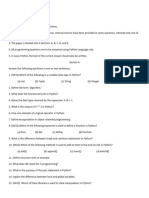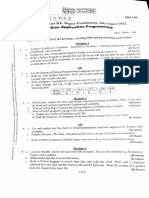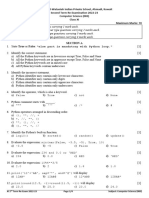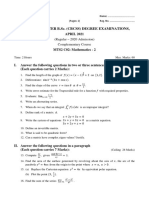0 ratings0% found this document useful (0 votes)
161 viewsA11 Python Programming
This document contains questions for a Python programming exam covering various topics like data types, operators, functions, strings, lists, dictionaries, sets, modules, selection and iteration statements.
The questions are divided into three sections - short answer questions in section I assessing basic concepts (2 marks each), paragraph questions in section II testing in-depth understanding (5 marks each), and essay questions in section III on advanced topics (10 marks each).
Section I contains 15 questions evaluating understanding of Python's interpreted nature, statements, identifiers, datetime module, tuple method index(), if-elif-else, function categories, list definition, ceil() function, dictionary removal, single element tuple, set addition/removal, boolean expressions and multi
Uploaded by
tiwoficCopyright
© © All Rights Reserved
Available Formats
Download as PDF, TXT or read online on Scribd
0 ratings0% found this document useful (0 votes)
161 viewsA11 Python Programming
This document contains questions for a Python programming exam covering various topics like data types, operators, functions, strings, lists, dictionaries, sets, modules, selection and iteration statements.
The questions are divided into three sections - short answer questions in section I assessing basic concepts (2 marks each), paragraph questions in section II testing in-depth understanding (5 marks each), and essay questions in section III on advanced topics (10 marks each).
Section I contains 15 questions evaluating understanding of Python's interpreted nature, statements, identifiers, datetime module, tuple method index(), if-elif-else, function categories, list definition, ceil() function, dictionary removal, single element tuple, set addition/removal, boolean expressions and multi
Uploaded by
tiwoficCopyright
© © All Rights Reserved
Available Formats
Download as PDF, TXT or read online on Scribd
You are on page 1/ 2
U 217303 Name: .......................................
(Pages: 2) Reg. No. ....................................
THIRD SEMESTER (CBCSS) DEGREE EXAMINATIONS,
NOVEMBER 2021
(Regular / Supplementary / Improvement)
Common Course – B.Sc. Computer Science, B.Sc. Electronics & B.C.A.
A11: Python Programming
Time: 2.5 Hours Max. Marks: 80
I. Answer the following questions in two or three sentences
(Each question carries 2 Marks): (Ceiling 25 Marks)
1. Why is python called an interpreted language?
2. What are statements in python? Give example.
3. What are python identifiers? Give example.
4. What is the purpose of datetime module in python?
5. Explain the purpose, syntax and usage of the built-in tuple method index( ). Ilustrate with
suitable examples.
6. Explain the simple if-elif-else statement in python.
7. What are the different general categories of functions in python?
8. How can you define and access lists in python? Ilustrate with examples.
9. Explain the purpose, syntax and usage of ceil( ) built-in function with an example.
10. How can you remove elements from dictionary? Ilustrate with suitable examples.
11. How can you create a tuple with single element in python? Ilustrate with example.
12. How can you add and remove elements in sets in python?
13. Explain how you can create complex boolean expressions using logical operators.
14. Explain how you can perform multi-way selection in python.
15. Explain the syntax, purpose and usage of the built-in string function capitalize( ) with
suitable examples.
II. Answer the following questions in a paragraph
(Each question carries 5 Marks): (Ceiling 35 Marks)
16. How python accepts user inputs? Explain with example.
17. List and explain various operators available in python.
18. What is meant by scope in python? What is meant by global scope? Illustrate its
significance with suitable example.
19. Describe the syntactic rules and usage of break and continue statements in python.
U 217303
20. Describe the purpose, syntax, usage of atleast five methods of the time module in python.
21. What is meant by scope in python? What is meant by local scope? Illustrate its
significance with suitable example.
22. What are the strings in python? How are strings defined and accessed in python?
23. What is meant by selection statements in python?
III. Write essays on any two of the following: (2 x 10 = 20 Marks)
24. Describe the syntactic rules and usage of while statement in python with example.
25. Describe python’s datatype.
26. What are dictionaries in python? How can you define and access dictionary elements?
Describe different methods of dictionaries in python.
27. Describe different types of arguments in python. Illustrate with examples.
You might also like
- Application Development Using Python: Model Question Paper-1 With Effect From 2018-19 (CBCS Scheme)100% (1)Application Development Using Python: Model Question Paper-1 With Effect From 2018-19 (CBCS Scheme)6 pages
- Visit:: Join Telegram To Get Instant Updates: Contact: MAIL: Instagram: Instagram: Whatsapp ShareNo ratings yetVisit:: Join Telegram To Get Instant Updates: Contact: MAIL: Instagram: Instagram: Whatsapp Share3 pages
- VTU Question Paper of 15CS664 Python Application Programming Jan-Feb-2023No ratings yetVTU Question Paper of 15CS664 Python Application Programming Jan-Feb-20232 pages
- PythonProgramming 22PLU105B Modelquestion Paper 2No ratings yetPythonProgramming 22PLU105B Modelquestion Paper 23 pages
- Application Development Using Python: Dept. of CSE, DSATM 2020-21 1100% (1)Application Development Using Python: Dept. of CSE, DSATM 2020-21 19 pages
- 21EC643 - Question Bank 1 for Modules 1 to 4No ratings yet21EC643 - Question Bank 1 for Modules 1 to 43 pages
- Mca 2 Sem Python Programming 2c8125 2023 (1)No ratings yetMca 2 Sem Python Programming 2c8125 2023 (1)3 pages
- Choice Based Core Course CC6CBT01 PYTHON AND LATEXNo ratings yetChoice Based Core Course CC6CBT01 PYTHON AND LATEX2 pages
- Application Development Using Python: Model Question Paper-1 With Effect From 2019-20 (CBCS Scheme)100% (1)Application Development Using Python: Model Question Paper-1 With Effect From 2019-20 (CBCS Scheme)3 pages
- Python Programming Unitwise Important QuestionNo ratings yetPython Programming Unitwise Important Question4 pages
- 1714391155857_1714391150646_SGRR Syllabus XI & XII CSNo ratings yet1714391155857_1714391150646_SGRR Syllabus XI & XII CS9 pages
- Pwp 22616 All in One (s22,w22,s23,w23,s24) Pyp-outputNo ratings yetPwp 22616 All in One (s22,w22,s23,w23,s24) Pyp-output19 pages
- Mastering Python Programming: A Comprehensive Guide: The IT CollectionFrom EverandMastering Python Programming: A Comprehensive Guide: The IT Collection5/5 (1)































































